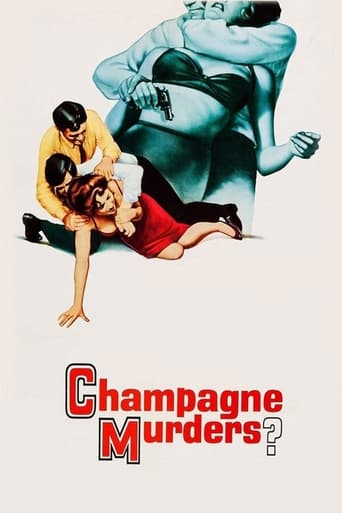enoughtoil
Spoiler alert: this review is all spoilers. But this movie is so bad that I don't think it's possible to spoil it any further. A reviewer who has praised the movie asserts that the Anthony Perkins character, Christopher, is in cahoots with the character, or rather characters, played by Stéphane Audran: Audran is Jacqueline when disguised as Christopher's mousy maid and she is the flashy Lydia when not in disguise. Lydia commits a bunch of murders and tries to pin them on Christopher's friend, the character named Paul who is played by Maurice Ronet. Lydia's plan is to benefit financially from the deaths of her murder victims and then live happily ever after with Christopher (why the beautiful and intelligent, albeit ruthless, Lydia would kill in order to be with a loser like Christopher is beyond my comprehension). But if Christopher is in on Lydia's plan, then the scene where he makes a play for Jacqueline and she rejects him makes no sense. Perhaps he could be in cahoots only with Lydia, not realizing that she is also Jacqueline, but that would mean that all it takes for a woman to deceive Christopher is not much more than her wearing of a wig. Christopher's being in cahoots with Lydia would also mean that he would be delighted when he learns that his wife, Christine, played by Yvonne Furneaux, has been murdered, when in fact he is distraught. The entire movie makes very little sense. With the partial exception of Christine, all the main characters are unprincipled and obnoxious people, so it is difficult to have much sympathy for any of them.
morrison-dylan-fan
Gathering up works from auteur film maker Claude Chabrol,I spotted a title starring Anthony Perkins. With Chabrol being very open about his inspiration from the "Master of Suspense" I decided that it was time to see Chabrol meet the psycho.The plot:Caught in the middle of a car crash, champagne businessman Paul Wagner finds himself unable to settle down.Spotting a weakness, Christine Belling and her husband Christopher try to get Wagner to sell the business to them.Getting a grip on what few sense he has left,Wagner pushes their advances to the side. Struggling to get his condition under control,Wagner starts to fear that the car crash affected him more than he originally believed,when Wagner's girlfriends start turning up brutally killed. View on the film:Backed by Universal studios, (which led to a French and English version both being shot) director Claude Chabrol and cinematographer Jean Rabier fizz up the lavish lifestyles of Paul and Christopher,as stylish tracking shots pull back to reveal the colourful surroundings when the murders "pop." Closing in on Wagner's fractured mind,Chabrol locks in with elegant,tightly held close-ups which heat up a tough edge Film Noir atmosphere,which is lit up by Wagner's attempts to unscramble his memories.Kicking off with a car crash that sends Wagner into a whirl,the screenplay by Claude Brulé/ Derek Prouse/ William Benjamin & Paul Gégauff delicately builds up the fractures between Wagner,Christopher and Christine Belling,with Wagner's blunt outbursts cutting him off as a Film Noir loner. Splashing the murders against the screen,the writers wonderfully press Wagner's anxiety down on the viewer,by making the viewer having to gather the loose reflections of Wagner's interactions with the victims, until the superb final shot "pulls back" to unveil the full puzzle.Carrying a sly grin on his face, Anthony Perkins gives a great performance as Christopher,whose calm, collected business manner Perkins peels away to uncover a ruthless, calculating bite. Pushed to put the cork back in the bottle by the gorgeous Yvonne Furneaux's femme fatale , Maurice Ronet gives an excellent performance as Paul Wagner.Covering Wagner in Noir shakes of disbelief,Ronet digs his nails into the tortured doubt of Wagner,as the murder victims get covered in champagne.
gridoon2018
This early Claude Chabrol thriller is rarely seen, but it's just as good as most of his later, more widely acclaimed films. The beginning is a little too languid (as one character puts it, their job is "to do nothing with distinction"), but once the first murder occurs, the film transforms into a gripping, Hitchcockian mystery. Chabrol is collaborating with his regular cinematographer and composer, so the photography and the music are up to his usual high standards. There are some stunningly beautiful women (Stephane Audran in red lingerie is worth the price of admission by herself....and why is Suzanne Lloyd so little-known?), and an equally stunning plot twist. But you must also be prepared for one of the strangest, most open-ended final shots you will ever see! *** out of 4.
christopher-underwood
This is not really an early Chabrol who had already been making films for over fifteen years but it does come just before he fully got into his stride and his golden period began with Le Boucher. Fascinating here to see Anthony Perkins with Maurice Ronet and the lovely Stephane Audran, not sure if he knew English or was dubbed but he looks fine. Trouble here is that Chabrol takes forever setting this up and we have to spend what seems an interminable amount of time as the rich are seen to party pathetically with their business transactions forever hovering. Once things do get going there are some great scenes and we struggle to make out who is doing what and for why. Could have done with some of that cinematic style early on but certainly worth a watch for the second half. Apparently referenced in Kill Bill 1 and 2 and I'm guessing that it is the final overhead scene shot in retreating fashion that could Tarantino's eye.




